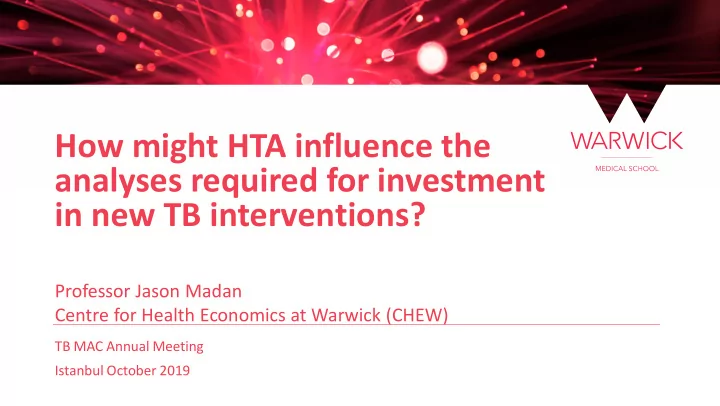

How might HTA influence the analyses required for investment in new TB interventions? Professor Jason Madan Centre for Health Economics at Warwick (CHEW) TB MAC Annual Meeting Istanbul October 2019
Role of HTA in the Global South • HTA and formal approaches to allocating scarce resources widely established in many high-income countries • LMICs are increasingly adopting more formal approaches to priority-setting (Chalkidou et al, 2016) • Networks such as the iDSI (https://www.idsihealth.org/) are developing methods and influencing stakeholders
Implications for adoption of TB interventions • TB interventions such as active case findings and novel diagnostics may require substantial investment • The resources required may only be made available based on formal HTA recommendations. • This has implications for the type of evidence and analysis required to obtain reimbursement. • Experience from bodies such as NICE may provide insights into these implications (even though the processes may be very different in LMIC settings)
Evidence-based implementation • Formal process for identification and review of appropriate evidence • Focus on gold standard evidence and use of standard quality assessment tools e.g. Cochrane Risk of Bias tool. • Challenge in some settings may be availability of suitable high quality evidence • Disadvantages interventions where data are challenging to collect • Role for bias adjustment methods (e.g. Bayesian synthesis, Watson 2016).
Move from effectiveness to cost-effectiveness • Greater need to present evidence on cost impact and cost-effectiveness • Goes beyond the immediate budgetary impact of implementation • Greater use of decision-analytic modelling • More patient-focussed outcomes and cost-utility analyses • DALYs, QALYs or something else? • Importance of value judgements which may vary across countries
Representing decision uncertainty • Move from hypothesis-testing to decision-theoretic approaches • Potential for value of information analyses to determine need for further evidence and how plausible cost-effectiveness of a novel intervention might be • Depends on determining willingness to pay thresholds, which may have been previously over-estimated.
Hurdles to successful reimbursement • ‘Value considerations are the primary driver of negative preliminary recommendations’ (Walton et al 2019) • To overturn, manufacturers had to reduce price, adopt risk sharing reimbursement, or focus on cost-effective subgroups. • Academic groups produced consistently less favourable ICERs than manufacturers • Areas of economics beyond economic evaluation become relevant: • Strategic game theory • Transaction cost economics
References • Chalkidou K et al. Priority-setting for achieving universal health coverage. Bulletin of the World Health Organization. 2016 Jun 1;94(6):462. • Watson SI, Lilford RJ. Integrating multiple sources of evidence: a Bayesian perspective. In Challenges, solutions and future directions in the evaluation of service innovations in health care and public health 2016 May. NIHR Journals Library. • Walton MJ, O’Connor J, Carroll C, Claxton L, Hodgson R. A Review of Issues Affecting the Efficiency of Decision Making in the NICE Single Technology Appraisal Process. PharmacoEconomics-open. 2019 Jan 8:1-8.
Recommend
More recommend